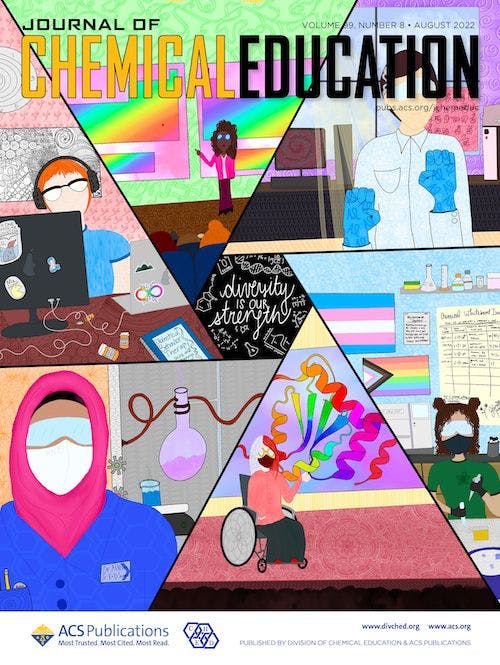Here, we bring you another round-up of the latest developments and thought-leading opinion for the use of ChatGPT in chemistry research and education.

Artificial intelligence (AI) is a powerful tool that is being increasingly used across diverse applications and fields. Perhaps the most well-known of these is ChatGPT—a natural language generation model that has become the fastest-growing consumer application in history. The technology has raised many concerns, but if we can find solutions to those, then it may offer promising potential for use in the laboratory, classroom, and beyond.
In a piece published in the Journal of Chemical Education, Eman Alasadi and Carlos Baiz discuss the role of generative AI in education, with a focus on opportunities, concerns, and solutions. The authors touch on diverse aspects of the technology, from the role in personalized learning experiences and adaptive resources to the potential for real-time feedback and assessment. AI translation also offers huge potential for overcoming language barriers in the classroom. Initial concerns from educators focused on academic integrity, accountability, and plagiarism—but proponents argue that AI tools are simply the latest in a line of advances that have been assimilated into education, from calculators to the internet. AI integration and planning will be the key to ensuring good practice in research and writing, as well as in helping students develop their critical thinking skills.
Read the article: Generative AI in Education and Research: Opportunities, Concerns, and Solutions
Critical thinking is a key topic of discussion when it comes to AI, as examined in this recent article on how ChatGPT-generated responses can be used as prompts for critique in a problem-solving workshop. Critical thinking is one of the key gaps pointed out by detractors of AI, since it requires questioning, analyzing, interpreting, evaluating, and making a judgment. At present, techniques such as worked examples and scaffolding aim to improve conceptual understanding and problem-solving confidence in students. Part of this learning process also includes working through intentionally erroneous solutions.
Since ChatGPT has been shown to make mistakes when solving chemistry problems, the team hypothesized that it could it be an efficient way to generate flawed solutions to help support human learning and strengthen critical thinking skills. The results of this classroom activity showed that students engaged with the idea of metacognition as part of a problem-solving toolbox, and they appreciated the collaborative nature of problem solving. They were also generally able to successfully identify mistakes and flaws in AI-generated solutions.
Read the article: Metacognition and Critical Thinking: Using ChatGPT-Generated Responses as Prompts for Critique in a Problem-Solving Workshop (SMARTCHEMPer)
In reverse, Chatbots may also help educators to understand student misconceptions. We accept that these AI tools cannot (currently) reason, and that their generated responses are based on pre-existing knowledge acquired from a vast amount of training data. But this in itself is useful, since educators can use AI as a model to evaluate student learning, and explore common misconceptions based on the provided training information. Vicente Talanquer’s interview with a Chatbot explores this idea, revealing some fascinating similarities between AI and chemistry learners.
Read the article: Interview with the Chatbot: How Does It Reason?
AI can also support with practice testing, which has been shown to be effective for memory retention. In his article on automated assessment with multiple-choice question banks, Maarten T. P. Beerepoot argues for the development of large question banks, which can be used in three key ways: formative assessment in large online classes, formative practice tests outside classes, and summative assessment through a digital exam.
Read the article: Formative and Summative Automated Assessment with Multiple-Choice Question Banks
It has been shown previously that producing high-quality multiple-choice questions is challenging for educators, with flaws common in more than half of questions across a number of fields. The benefit of AI here is therefore in developing the questions, as well as supporting automated assessment plus immediate feedback to learners in a time-efficient manner, free from assessment bias.
These kinds of tools can be expanded into intelligent, technology-based tutoring systems that can adapt the learning experience to better serve individual users, as described by researchers using DiscoverOChem—a free learning platform to support organic chemistry for undergraduates. The team analyzed previous students' data to see how well individual students performed on various pages of the platform, and they used this information to develop and evaluate predictive models. The result is that the system can provide a warning for pages that are expected to be difficult for that user, along with links to recommended materials.
Read the article: Incorporating an Intelligent Tutoring System into the DiscoverOChem Learning Platform
There is no question that AI-driven tools are transforming the learning experience and enhancing research productivity. By allowing certain processes to be streamlined, AI can help researchers navigate complex science and contribute to groundbreaking discoveries. But for all these positives, there still remain shortcomings: ChatGPT cannot perform mathematical operations reliably, it often makes conceptual errors, and it also commits the exceptional publishing sin of fabricating citations. Furthermore, as systems evolve, it is likely new challenges will emerge around access, equity, and accountability. In order to harness the potential of AI responsibly and effectively, everyone in the chemistry community must engage in a conversation about both its benefits and pitfalls.
Read the article: Shortcomings of ChatGPT

Stay Connected
